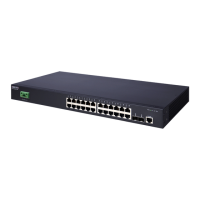C
HAPTER
28
| Port Mirroring Commands
RSPAN Mirroring Commands
– 767 –
COMMAND MODE
Global Configuration
COMMAND USAGE
◆ Only one destination port can be configured on the same switch per
session, but a destination port can be configured on more than one
switch for the same session.
◆ Only 802.1Q trunk or hybrid (i.e., general use) ports can be configured
as an RSPAN destination port – access ports are not allowed (see
switchport mode).
◆ Only ports can be configured as an RSPAN destination – static and
dynamic trunks are not allowed.
◆ The source port and destination port cannot be configured on the same
switch.
◆ A destination port can still send and receive switched traffic, and
participate in any Layer 2 protocols to which it has been assigned.
EXAMPLE
The following example configures port 4 to receive mirrored RSPAN traffic:
Console(config)#rspan session 1 destination interface ethernet 1/2
Console(config)#
rspan remote vlan Use this command to specify the RSPAN VLAN, switch role (source,
intermediate or destination), and the uplink ports. Use the no form to
disable the RSPAN on the specified VLAN.
SYNTAX
[no] rspan session session-id remote vlan vlan-id
{source | intermediate | destination} uplink interface
session-id – A number identifying this RSPAN session. (Range: 1-2)
Only two mirror sessions are allowed, including both local and
remote mirroring. If local mirroring is enabled with the port monitor
command, then there is only one session available for RSPAN.
vlan-id - ID of configured RSPAN VLAN. (Range: 2-4092)
Use the vlan rspan command to reserve a VLAN for RSPAN
mirroring before enabling RSPAN with this command.
source - Specifies this device as the source of remotely mirrored
traffic.
intermediate - Specifies this device as an intermediate switch,
transparently passing mirrored traffic from one or more sources to
one or more destinations.
